“The Youth of Russia” Russian National Youth Art Festival “Union of Russia’s Artists: Probation // Today / Tomorrow”
The Union of Russia’s Artists (URA), one of Russia’s oldest and largest alliances of visual artists and a Russian national non-profit, regularly holds exhibitions of young artists. Thanks to its expansive geographical reach (the URA has chapters in every Russian region) and pool of experts in every field of art, the URA has the intellectual resources necessary to spot and support new talent, and the Union’s efforts to popularise art include promoting young Russian artists exploring a wide range of creative practices.
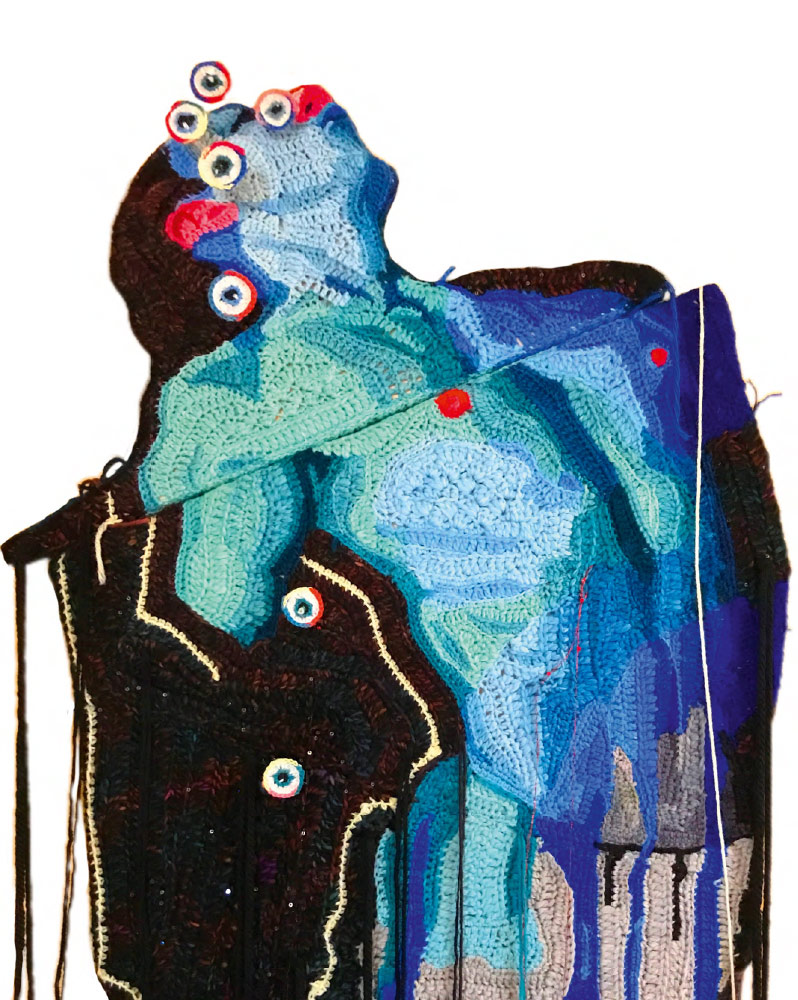
KATIKA. Oil. 2021
Triptych, left part. Wool, canvas, crochet. 150 × 250 cm. Detail
The professional community considers the URA to be an organisation that carries the torch for the traditions that originated in the mid 19th century and also the in the “Peredvizhniki” (“Wanderers”) movement of the last third of the 19th century. However, the URA understands these traditions not as centuries-old canon lifted by the academic school to the top of the hierarchy and never to be challenged, but as a paradigm of continuous reinvention of art idioms in the context of different time periods. The URA is not opposed to artistic experimentation and its structure is based on a constructive balance of aesthetic, ethical and professional priorities.
The 2021 Russian national exhibition “URA: Probation//Today/Tomorrow” was one of the URA’s most noteworthy projects, on a par with the world’s biggest international art shows and biennales. This exhibition rounded off a two-year educational exhibition programme that was part of the Russian national youth art festival “The Youth of Russia”: the festival was sponsored by the Fund of Presidential Grants under the auspices of the National Culture Project, supported by Russia’s Ministry of Culture. Another source of support was a grant from the Russian Culture Fund. In 2020, the URA, at its exhibition space at the New Tretyakov Gallery on Krymsky Val, hosted an exhibition showcasing the best works featured in two previous shows - the exhibition and competition “New Times” and the Russian national show of young artists “New Times 2.0”, both of which featured young artists aged 18-35 and highlighted a particular aspect of the artwork produced by young Russian artists.
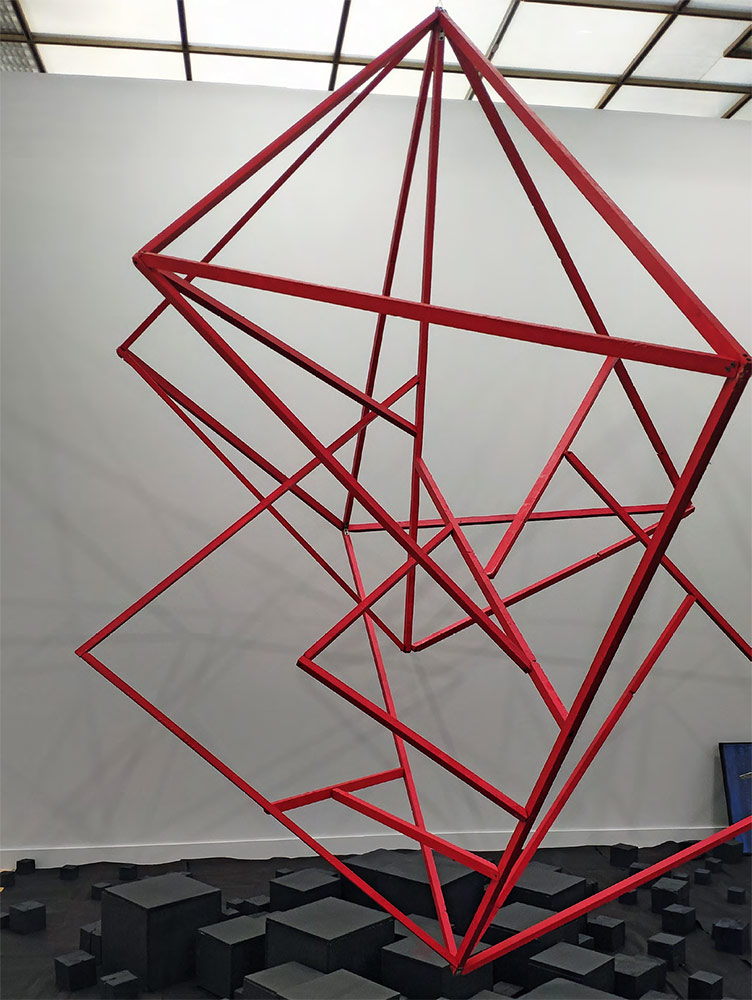
Elena KORNEEVA. Elemental. 2021
Wood, installation
“New Times”, “New Times 2.0” and “URA:Probation//Today/Tomorrow” are unlike the regular traditional shows of young artists organised by the URA - the concept of these events is cardinally different. The main goal of the Russian youth art festival “The Youth of Russia” is to start a dialogue between classic views on art and “new forms”. The show’s organisers pursued an ambitious goal - bringing together a variety of forms, practices and trends in contemporary art and, in doing so, promoting a dialogue between practitioners of different aesthetic formats. Until quite recently, proponents of these different creative methods were confrontational towards each other, but, today, this confrontation is being replaced by the necessity of working in cooperation with each other and engaging with the same historical, sociocultural, philosophical and professional problems that all thoughtful modern artists are faced with. That was why the festival was designed as a multi-stage event: an open-call competitive admission, then probation, then the culmination: a large-scale Russian national exhibition.
Within the framework of the project in 2021, the URA administered a one-month program of artistic internships for 100 young artists from all over the country, which took place at various art centres, with experienced artists acting as mentors. During that period. the Kardovsky Arts Centre (in the town of Pereslavl-Zalessky), the Repin Academic Summer House (in the town of Vyshny Volochyok), the Senezh Work and Recreation Centre for Artists (in the town of Solnechnogorsk), the Visual Arts Centre Cheluskinskaya (in Moscow Region), and the Baikal Arts Centre (in the city of Irkutsk) were turned into artist residencies offering, on a daily basis, experimental artistic labs, plein air sessions, portfolio revues, artist talks, masterclasses, lectures, reading groups, performances, exhibition selection panels, discussions and themed training sessions.
These activities generated a wide variety of artworks in different genres and forms in five key media - painting, drawing, sculpture, applied arts and “new forms” - which provided a comprehensive understanding of present-day youth art.
In line with the leading current trends of the international arts scene, when preparing this multi-stage project, the URA enlisted young curators and coordinators (A. Grumbina, V. Gorbacheva, A. Guseva, L. Levandovskaya) and exhibition designers (A. Vilches-Nogerol, Vera Lagutenkova) to organise and carry out the internships and the subsequent exhibition of the young artists. This had an impact on the tonality of the pieces on view, on their manner of presentation and on the thematic and architectural dimensions - what is usually called the artistic arrangement of the exhibition spaces - of the show’s overall concept.
In keeping with the spirit of the times, when a whirlwind of news sweeps across the digital space non-stop, even the show’s name - “URA: Probation//Today/Tomorrow” - evokes http addresses and the habitual form of the notation of periodicals, with its hierarchy of colons, slashes and hashtags. The period of the young artists’ involvement with the URA, and of their artistic internships arranged by the URA, is indeed brief. Young people are working today in order to understand themselves and the times they live in - and anxiously waiting for a new day when they can make new artistic discoveries.
Anticipating the visitors’ questions about the show’s visual zoning, the team of curators and coordinators rejected the customary didactic approach in explication on principle. The propaedeutics for the show - an assemblage of texts at the entrance to the exhibition - were in a Q&A format. The composition resembled a chat in a messenger, with questions and answers - a format thoroughly familiar to young people, in whose lives today this form of digital communication is often substituted for face-to-face contact.
The traditional principle of checking off artwork grouped in separate rooms by form and genre was discarded in favour of an arrangement based on nodes of semantic strength, drawing around them special areas of attention to specific themes: “love - loneliness”, “urban environment - zones of natural escapism”, “living online - the tactile experience of existence”, and “memory of ancestors - evidence of the transitoriness of fleeting moments”. And all of this was captured in paintings, bronze, stone, chamotte, glass, clay, on paper, in installations, embroidery over objets trouves, video art, and “the artist’s books”.
The fired, unpainted ceramic letters of Daria lukkanen (Moscow) in her piece “Who Needs This Art” were a key to understanding the exhibition’s concept and contemporary views on art in general. This sentence did not feature punctuation: the viewer was given the chance to interpret the multiple-choice presentation of an artistic statement.
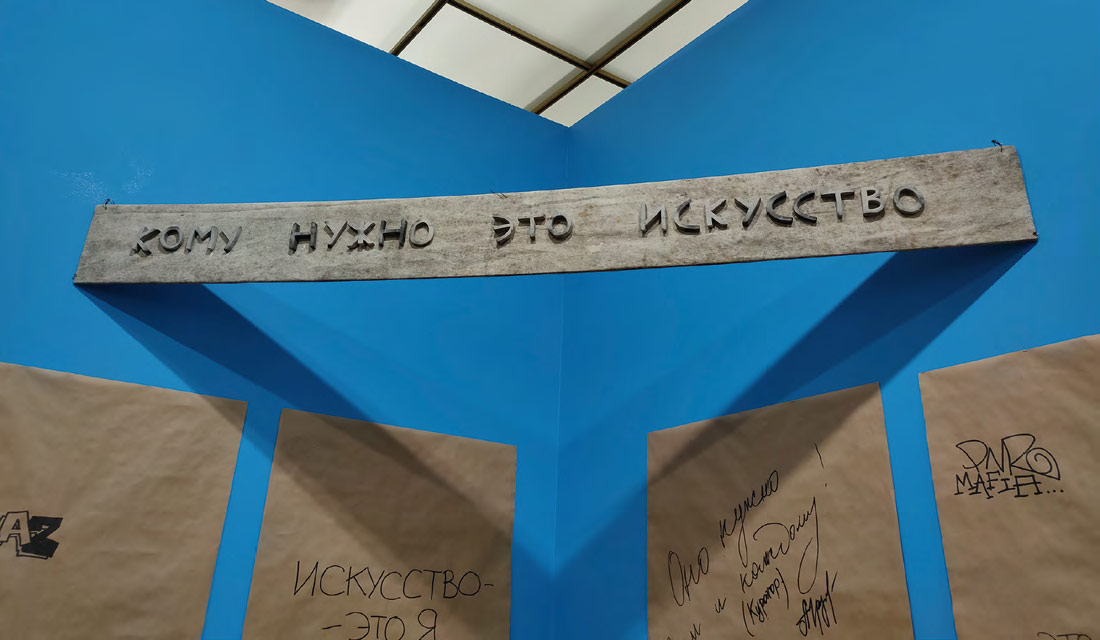
Daria IUKKANEN. Who Needs This Art. 2021
Chamotte, pit firing, found object
In his series of paintings “Rostov Contrasts” (Rostov-on-Don, oil on canvas), using nearly movie-like closeups, Aleksander Savelenko unsparingly singled out, amid the mundanity, fragments perceivable as inevitable axioms, with the irony and genuine warmth of an observing philosopher.
The stern, poster-like iconic visages in Yelizaveta Netreba’s “Legends of Lake Baikal” swapped places with the viewers, as if inquiring who had the real knowledge of life - rushed contemporary urbanites or these nearly shamanistic sculpted masks of idols.
Kirill Stryukov (Stavropol, “Red Evening, White Snow”; “Taganskaya Subway Station”; oil on canvas), Borislava Vorotilo (Moscow, “The Time Has Come”, oil on canvas), Ksenia Sopova (Moscow, “Primavera”, oil on canvas), Rena Averina (Krasnoyarsk, “Fluidly” triptych, street art in acrylic), Veronika Akopyan (Moscow, “100% Fur”, installation, digital art) and many other featured artists broached issues of self-identification and the choice of vectors to live by in the new, post-industrial, urban frame of reference. And the side-by-side display of works of different formats, executed with different media and techniques, played up the inner conflict of the artist working in the internally contradictory present-day realities, where borders between inner and external selves are blurred.

Borislava VOROTILO. The Time Has Come. 2021
Oil on canvas. 93 × 193 cm
Many artists engaged with themes of perception of historical contexts and self-adaptation to them through intimate emotions stemming from their personal experiences and family chronicles. Murat Anayev’s painting (Moscow, “Kyiiz [felted cloth]”, oil on canvas) featured three generations of women carefully rolling up a handmade rug still warm from the women’s skilled and patient hands. Julia Mortiis’s project “Freedom/Penal Labour” (St. Petersburg, installation, second-hand textiles, mixed media) addressed the difficult question of the status of people whose lives society labels as criminal.
Young people often become an object of criticism - they are faulted for their supposed lack of respect for the elderly and abundance of emotions not backed up by experience; they are reprimanded for their lack of professionalism, the one-sided nature of their statements, the effrontery of their self-expression, their lack of taste. Nonetheless, a careful viewer would see through the ornateness of forms and behold the eternal eschatological questions: behind affected brutality, solid training and behind provocative subjects, a mature wisdom.
The exhibition “URA:Probation//Today/Tomorrow” was an act of artistic self-diagnosis in the here and now. The exhibition accommodated a variety of young artists’ works, which included large-scale knitted “slaves bursting asunder their chains” (Katika, Moscow, “Oil”, crocheted wool and canvas), a piece highlighting a global ecological catastrophe; an exploration of the issue of accepting one’s own physicality via integration of visual glitches into painting (Polina Suvorova, Moscow, “Russian Beauty”, oil on canvas); classical compositions focused on the sacrament of prayerful intercession in a church (Oleg Ozhogin, Moscow, “Little Flock”, oil on canvas); observations of a world perennially in flux but also invariably full of vital force (Veronika Vologzhannikova. Murmansk, “How I Met Your Mother or One Very Famous Story”, chamotte, reduction by firing; Arina Obukh, St. Petersburg, “Pilgrims”, chamotte, glazes; Klim Senev, Stavropol. “Fitness”, chamotte, reduction firing, glazes) and many others. Visitors could leaf through the menu of Dasha Purpurnaya’s installation “Open Heart Bar” (Veliky Novgorod) and choose from among the cocktails of emotions, which were described in terms of their aftertaste and price tags for broken glassware. For visitors with a preference for graphic art, the exhibition’s offerings included drawings full of harsh contrasts by Viktor Poletayev (Irkutsk), as well as the most finely executed pieces of Yelena Mashkarina (St. Petersburg).
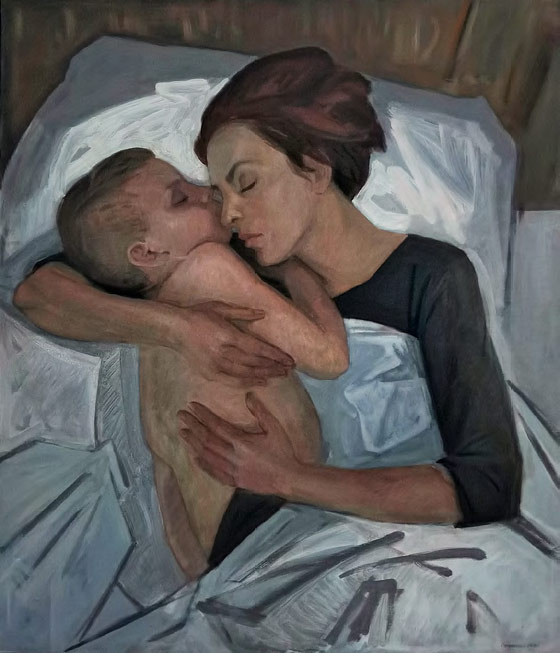
Olga SEMCHENKO. I will Cover You with a Wing and a Prayer. 2021
Tempera on canvas. 127 × 109 cm
A distinctive sign of the times is the prevalence of women among visual artists. They explore all avenues of creativity and this, of course, was reflected in the themes of a large number of their works. Many artists featured at the show addressed themes of love, family life and family values, thanks to which this exhibition had more optimistic, cheerful paintings, sculptures, and graphic pieces than previous events. An original vision distinguished the works of Daria Rumyantseva, Olga Semchenko, Anna Sinelshchikova, Margarita Gornostayeva, Olga Stenyayeva, Anna Lupenticheva and many other artists showcased at the exhibition. Yelena Korneyeva philosophically and visually interpreted “Loneliness” and “Love” (glass, mirror, metal, welding) as two forms of the same reality. In one work, fragments of broken glass were scattered all over the place; in another, they came together to form a shining crown. It was important to the artist that viewers could see themselves reflected in the fragments of glass.
Painting has updated its palette, focusing predominantly on delicate translucent tones, and using colours in conjunction with meticulously wrought forms. Large- scale thematic, subject-oriented compositions were replaced with small-scale series focused on the nuances of the everyday routines of apartment dwellers - the so-called small pleasures of life. The exhibition became not so much a reflection of an era as a kaleidoscope of non-accidental accidents.
The backstage section, on a separate wall of the exhibition space, featured behind-the-scenes correspondence of the artists groups during their internships. The messages were presented in the form of screenshots: in their letters, the young artists shared their plans, settled professional disputes and simply exchanged daily news. The printouts of the in-group correspondence formed what might be called a collective artistic diary, bringing to the mind Akhmatova’s line about secrets of the trade: "If you could know what gibberish empowers / The verse that grows, from all abashment freed.” [1]

Backstage zone at the exhibition “URA:Probation//Today/Tomorrow”. Panel 3,000 × 2,000 cm
Perhaps one of the most common misperceptions is the view, held by many in artistic communities, that young Russian art has no individuality. Only an incurious mind can think that. But the issues inherent in the relations between “fathers and sons” are still pertinent, and it will be only after some time that the works on display will be fully appreciated.
After every turn of the tide of history, the art of the young is faced with the dichotomy between “training and individuality”. Will I be noticed if I continue doing something that has been done for decades and centuries before I was born? And if I master the professional skills better than anyone, will my name become known? What should an artist do to become popular?
Participants in the show and visitors left their comments in the feedback book: “Well, and so what? Who won in this battle of so-called ‘modern classical art’ and so-called ‘new art’: the realists or the one-hit wonders?” Time will tell...
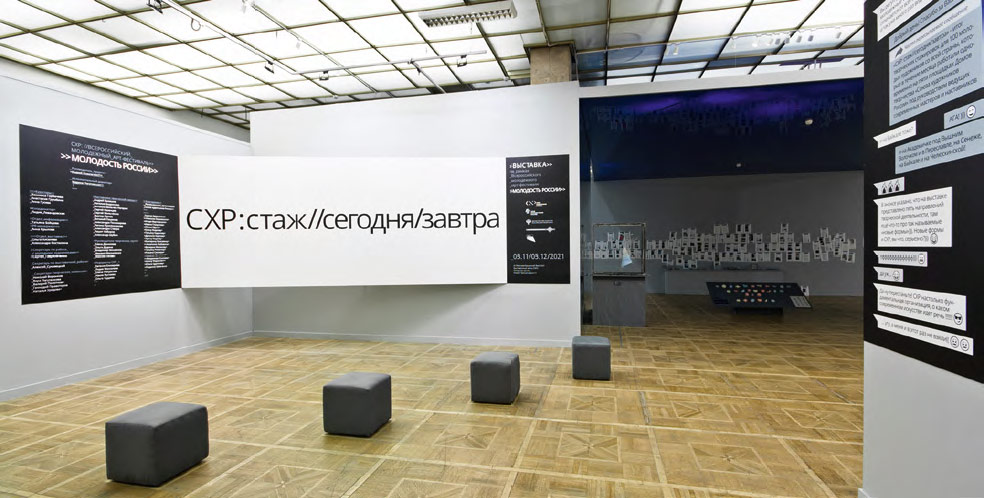
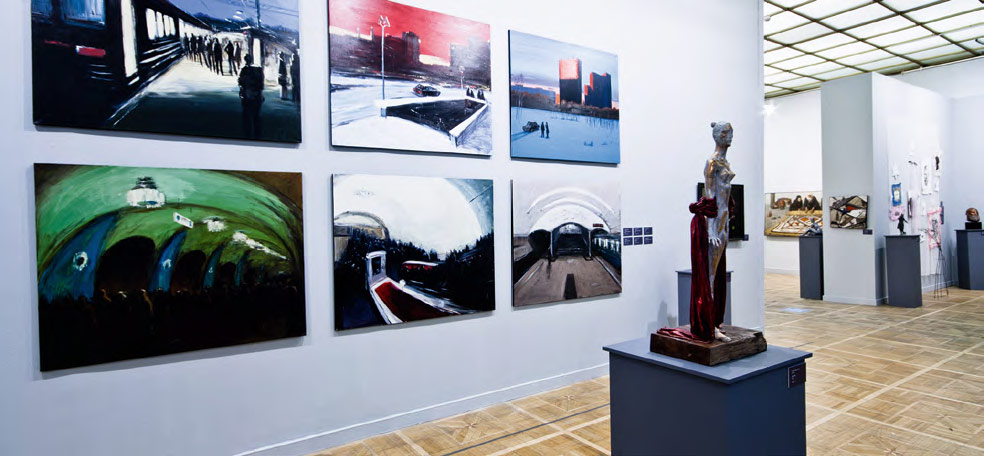
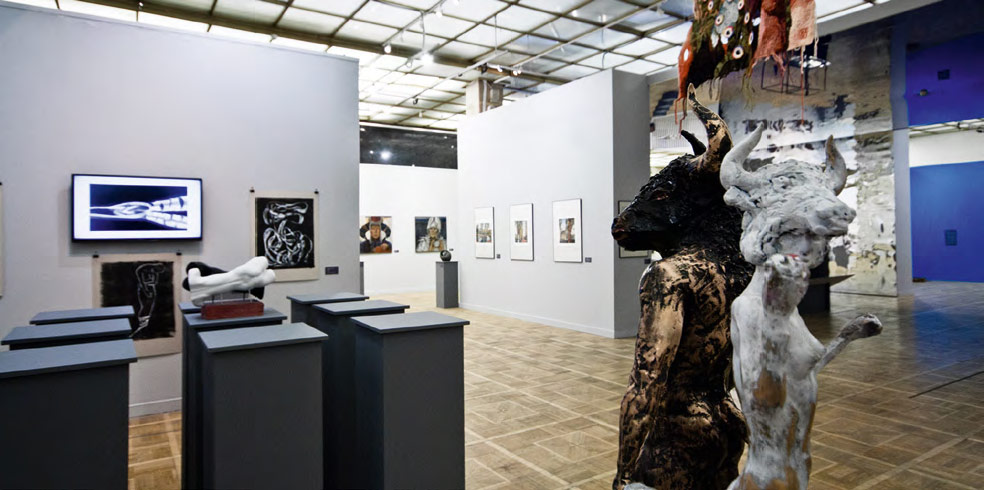
Exhibition “URA:Probation//Today/Tomorrow” held at the New Tretyakov Gallery in Moscow from November 5 to December 5, 2021
Photographs of exhibition halls
Acrylic on canvas. 80 × 60 cm
Oil on canvas
Oil on canvas. 80 × 100 cm
Sheets 1, 2, 3. Pastel, pencil on paper. 60 × 84 cm
Sheets 1, 2, 3, 4. Colour xylography. 40 × 50 cm
Dyptich. Oil on canvas. 122 × 197 cm
Dyptich. Oil on canvas. 122 × 197 cm
Oil on canvas. 90 × 80 cm
Chamotte, oxides, glazes, reduction firing. 44 × 30 × 37 cm
Chamotte, oxides, glazes, reduction firing. Details
Oil on canvas. 100 × 80 cm
From the "White Nights" series. Colour autolithography. 40 × 40 cm
From the "White Nights" series. Colour autolithography. 40 × 40 cm
Oil on canvas. 104 × 171 cm
Oil on canvas. 115 × 215 cm
From the “Rostov Contrasts” series. Oil on canvas. 90 × 80 cm
From the “Car Enthusiasts” series. Oil on canvas. 65 × 130 cm
Oil on canvas. 110 × 120 cm
Engraving. 44 × 29.5 cm; 49.5 × 31.5 cm; 44 × 29.5 cm
Cross aquatint, stroke, reservage
Chamotte, engobe coating, fire baking
Decorative panel. Triptych. Chamotte, glaze. 48 × 100 cm
Installation. Mixed media
Oil, acrylic on canvas. 110 × 135 cm
Oil, acrylic on canvas. 110 × 135 cm
From the series "Children's Playground". Colour autolithography. 43 × 48 cm
Russian Beauty
Russian Beauty 1
Russian Beauty 5
2021
Oil on canvas. 40 × 50 cm (each part)
Installation and detail of installation
Wool, canvas, crochet. 150 × 250 cm
Found textile, embroidery. 30 × 30 cm





























![Murat ANAYEV. Kyiiz [Felted Cloth]. 2021](https://www.tg-m.ru/img/mag/2022/1/art_74_01_25_1.jpg)

























